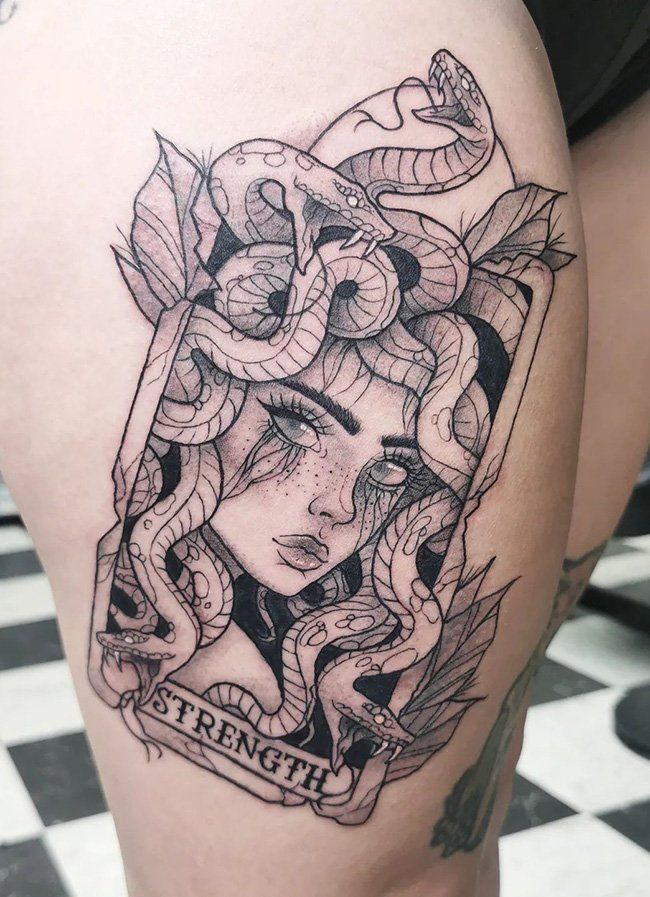The Medusa tattoo is one of the most captivating and mysterious designs in the world of body art. Rooted in Greek mythology, Medusa is a figure who has fascinated people for centuries. Known as the Gorgon with snakes for hair and a gaze that could turn men to stone, she is both feared and admired. This duality—danger and beauty, power and vulnerability—makes the Medusa tattoo a highly symbolic choice for those who want meaningful body art.
Many people view Medusa as a representation of feminine strength, resilience, and protection. Others see her as a symbol of transformation, vengeance, or justice. The Medusa tattoo has grown in popularity not only for its mythological significance but also for its versatility in tattoo art. From realistic portraits to abstract, minimalist designs, Medusa tattoos can be adapted to reflect deeply personal meanings.
In this article, we will explore 11 Medusa tattoo ideas, examining their symbolism, artistic styles, and ideal placements. Whether you’re drawn to mythology, looking for a symbol of empowerment, or simply inspired by striking tattoo designs, these ideas will give you plenty of inspiration for your next ink.
1. Realistic Medusa Portrait Tattoo

A realistic Medusa portrait tattoo captures the mythological figure in lifelike detail. Artists often focus on her haunting eyes, intricate snake hair, and fierce expression, making it one of the most striking tattoo options. This design works best in black and grey realism or color realism, depending on the wearer’s preference.
The power of this design lies in its ability to showcase Medusa’s dual nature: both beautiful and terrifying. A realistic portrait often emphasizes her feminine features while still incorporating the serpents, creating a balance between allure and danger. Many people choose this style to express resilience, transformation, or the ability to overcome betrayal and challenges in life.
Ideal placements for realistic Medusa tattoos include the upper arm, thigh, or back, where the artist has enough space to work on fine details.
2. Medusa Head Tattoo

The Medusa head tattoo is a bold design that focuses entirely on her face and serpent hair. This design often highlights her eyes, sometimes depicted as glowing or ominous, symbolizing her power to petrify enemies.
A Medusa head tattoo can represent protection, as the Gorgon’s image was once used in ancient Greece as a ward against evil. For many, it serves as a powerful reminder of strength and resilience in the face of adversity.
This tattoo style is highly versatile and can be done in a small, minimalist form or as a large, dramatic piece. The forearm, calf, or chest are great placements for this design.
3. Minimalist Medusa Tattoo
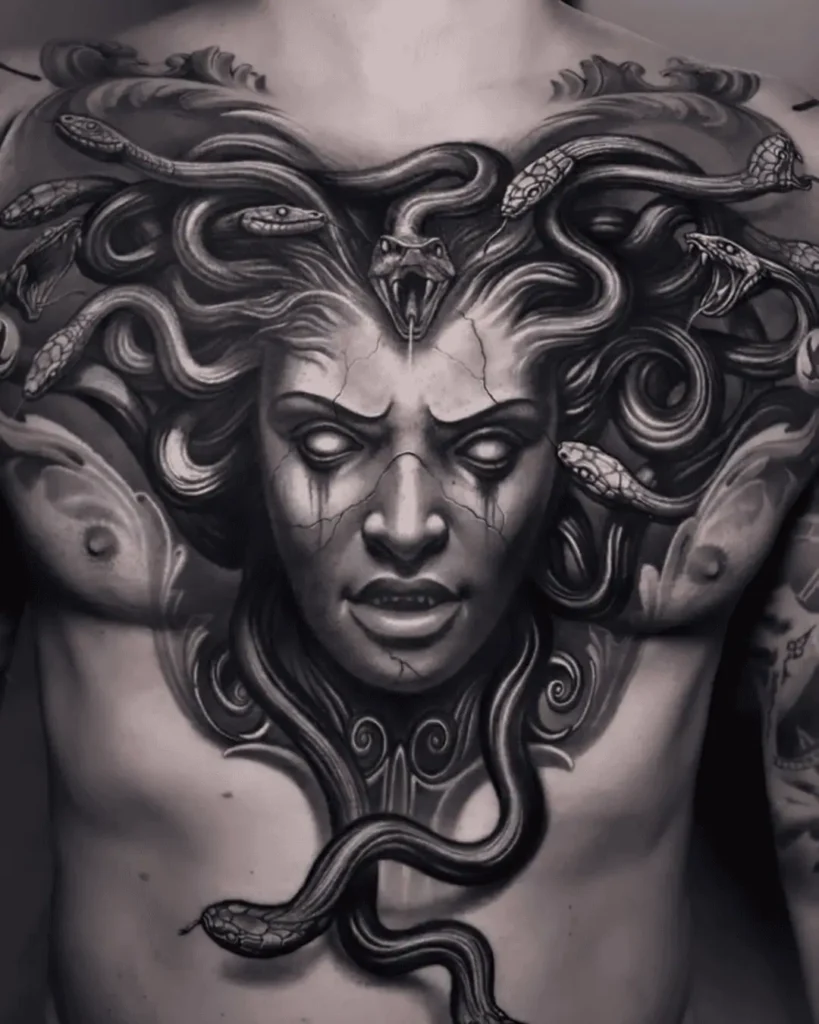
Not all Medusa tattoos need to be highly detailed. A minimalist approach uses fine lines and simple shapes to capture Medusa’s essence. Often, the focus is on her face outline or a symbolic element like a few serpent shapes.
Minimalist Medusa tattoos are popular among those who want something subtle yet meaningful. Despite its simplicity, this style carries the same depth of symbolism—strength, feminine energy, and transformation—while maintaining a clean, modern aesthetic.
This design works well on smaller areas such as the wrist, ankle, or collarbone. It’s perfect for those who prefer understated tattoos with powerful meanings.
4. Medusa Eyes Tattoo

The Medusa eyes tattoo is one of the most unique interpretations. Instead of showing her full portrait, the tattoo focuses solely on her piercing gaze. In mythology, Medusa’s eyes were her deadliest weapon, capable of turning people into stone.
This tattoo design can symbolize protection, strength, and the ability to overcome challenges with sheer determination. Some also view it as a symbol of awareness, inner vision, and intuition.
Placed on the forearm, shoulder, or even the chest, a Medusa eyes tattoo is both striking and symbolic, perfect for those who want a powerful yet minimalist design.
5. Medusa and Snake Tattoo

Since snakes are an inseparable part of Medusa’s identity, a Medusa and snake tattoo emphasizes the serpentine symbolism. The design often combines her portrait with detailed snakes winding around her head, shoulders, or arms.
Snakes in tattoo art often represent rebirth, transformation, and protection. Combined with Medusa’s story, this tattoo becomes a powerful symbol of resilience and the ability to rise from hardship stronger than before.
This tattoo style is often done in bold, intricate detail, making it ideal for larger placements like the back, thigh, or full sleeve.
6. Black and Grey Medusa Tattoo
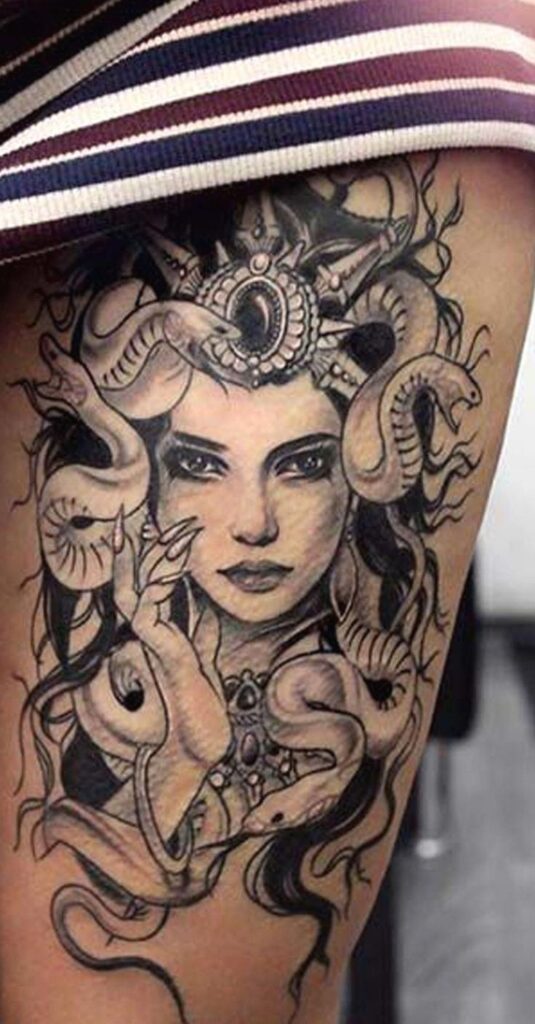
For a timeless and dramatic effect, many people opt for a black and grey Medusa tattoo. This style uses shading, depth, and contrast to bring out Medusa’s haunting beauty. Unlike colorful designs, black and grey tattoos give a darker, more mysterious feel, enhancing the mythical aspect of the Gorgon.
This design is perfect for those who want to emphasize Medusa’s tragic and powerful nature. It can symbolize strength, loss, or survival, making it deeply personal.
The versatility of black and grey tattoos allows them to fit well on the arm, chest, or leg, and they often age gracefully compared to colorful inks.
7. Medusa Chest Tattoo
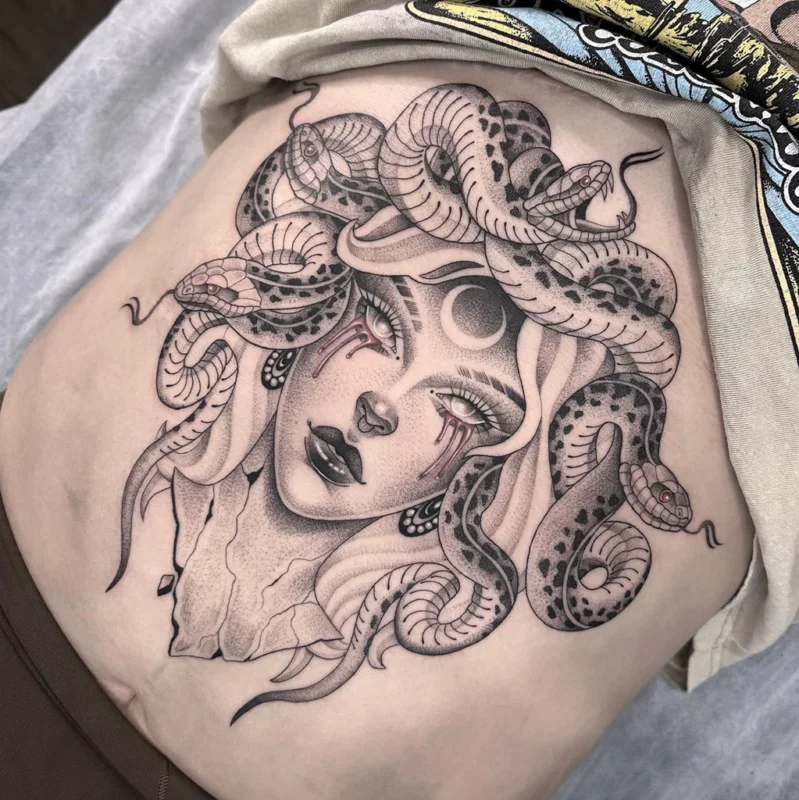
A Medusa chest tattoo is a bold statement piece. The chest is one of the most visible and central areas of the body, making it a strong placement for such a symbolic design. A Medusa tattoo here can represent protection, as if she is guarding the wearer’s heart and soul.
Artists often create symmetrical chest tattoos with Medusa’s face in the center and snakes extending outward, enhancing the overall impact. Some designs incorporate other mythological elements like shields, swords, or Greek patterns for added depth.
This tattoo style is perfect for those who want to make a powerful, unmissable statement with their body art.
8. Medusa Sleeve Tattoo

For tattoo enthusiasts who want a larger, more detailed design, the Medusa sleeve tattoo is an excellent choice. This style allows for intricate storytelling, combining Medusa’s portrait with snakes, mythological symbols, and even battle scenes.
A sleeve tattoo can reflect the complexity of Medusa’s story—her beauty, curse, and transformation into a symbol of strength. This design can also incorporate personal elements, making it a unique and meaningful piece.
Since sleeve tattoos cover a large area, they require multiple sessions and a skilled artist who specializes in realism or illustrative tattooing.
9. Feminine Medusa Tattoo

While Medusa is often portrayed as fierce and terrifying, some choose to emphasize her softer, feminine qualities. A feminine Medusa tattoo highlights her beauty, grace, and strength as a woman. Artists may focus on delicate facial features, flowing lines, and softer snake designs, creating a more elegant interpretation.
This tattoo can symbolize empowerment, independence, and resilience, making it especially popular among women. It reflects the idea of reclaiming Medusa’s story as one of strength rather than simply a curse.
Placements like the thigh, back, or upper arm allow this design to shine with elegance and detail.
10. Traditional Medusa Tattoo
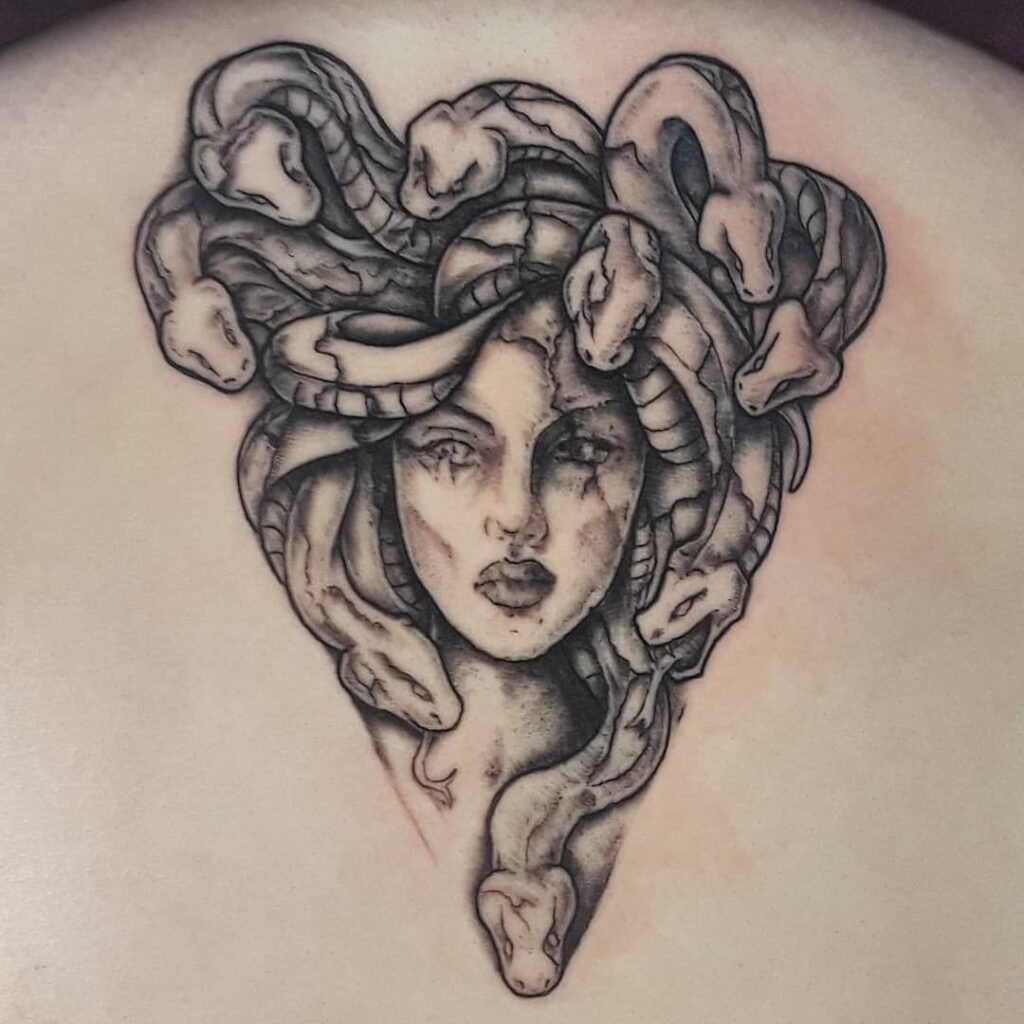
A traditional Medusa tattoo draws inspiration from old-school tattoo styles, featuring bold outlines, vibrant colors, and classic shading techniques. These tattoos often depict Medusa with exaggerated features, including dramatic eyes and stylized snakes.
This design combines the timeless appeal of traditional tattoo art with the rich symbolism of Greek mythology. It’s a great option for those who appreciate both mythology and classic tattoo culture.
Traditional Medusa tattoos are often placed on the forearm, calf, or shoulder, where their bold colors and lines can stand out.
11. Medusa with Symbolic Elements

The final idea combines Medusa with additional symbolic elements to create a deeper, personalized tattoo. For example, some people add shields or swords to represent protection, roses to symbolize beauty, or skulls to emphasize mortality and power.
This style allows wearers to tailor the tattoo to their own life story and values. By combining Medusa with personal symbols, the tattoo becomes more than just mythology—it becomes a narrative of resilience, growth, and individuality.
Such designs work well on large areas like the back, ribs, or thigh, where there’s enough room to integrate multiple elements seamlessly.
Symbolism and Meaning of Medusa Tattoos
The Medusa tattoo carries multiple layers of meaning. For some, it represents feminine power, independence, and protection against harm. For others, it symbolizes vengeance, transformation, or justice. Many people also see Medusa as a reminder of survival and overcoming challenges.
Medusa’s image has evolved over centuries—from being feared as a monster to being reinterpreted as a feminist symbol of strength and resilience. Today, the Medusa tattoo reflects not only mythological beauty but also deeply personal empowerment.
Best Placements for Medusa Tattoos
The placement of a Medusa tattoo often depends on the size, style, and symbolism behind it. Some popular options include:
- Forearm: Great for showcasing detailed portraits.
- Chest: Symbolizes protection and power.
- Back: Offers a large canvas for elaborate designs.
- Thigh: Ideal for larger, feminine Medusa tattoos.
- Wrist or ankle: Perfect for minimalist or subtle designs.
Each placement can alter how the tattoo is perceived, making it important to consider both design and meaning when choosing the location.
Conclusion
The Medusa tattoo is one of the most powerful and versatile designs in tattoo art. From realistic portraits to minimalist outlines, each style reflects different aspects of her mythology and symbolism. Whether you see Medusa as a protector, a survivor, or a symbol of empowerment, there are countless ways to express her story through body art.
These 11 Medusa tattoo ideas provide inspiration for anyone looking to embrace her mythical power. With careful consideration of design, style, and placement, a Medusa tattoo can become a deeply personal and meaningful work of art that tells your story of strength, resilience, and transformation.
